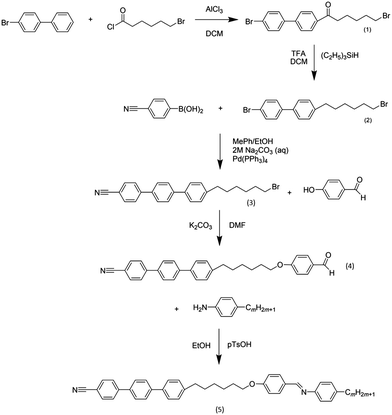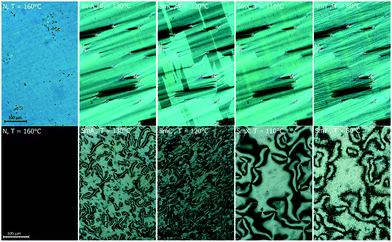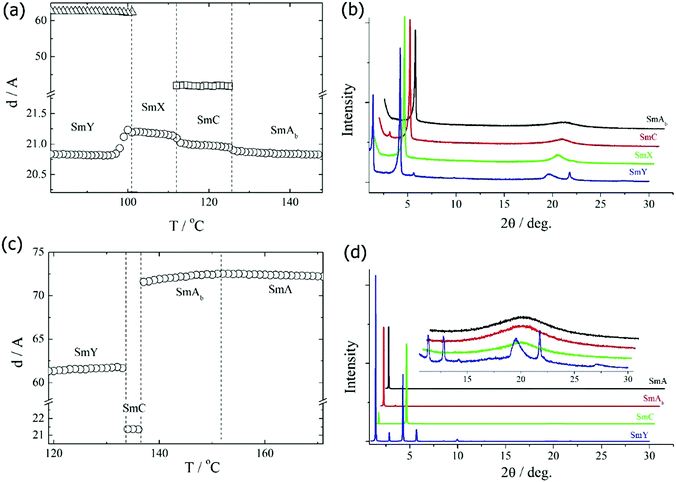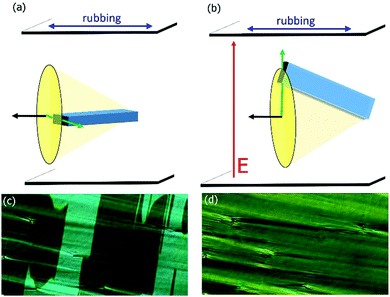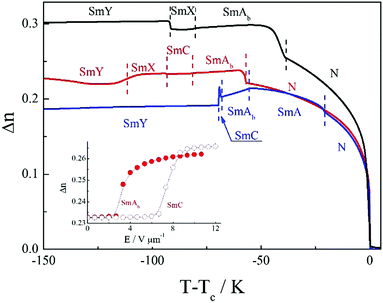 Open Access Article
Open Access ArticleRemarkable smectic phase behaviour in odd-membered liquid crystal dimers: the CT6O.m series†
Rebecca
Walker
 *a,
Damian
Pociecha
*a,
Damian
Pociecha
 b,
John M. D.
Storey
b,
John M. D.
Storey
 a,
Ewa
Gorecka
a,
Ewa
Gorecka
 b and
Corrie T.
Imrie
b and
Corrie T.
Imrie
 a
a
aDepartment of Chemistry, School of Natural and Computing Sciences, University of Aberdeen, AB24 3UE Scotland, UK. E-mail: rebecca.walker@abdn.ac.uk
bUniversity of Warsaw, Faculty of Chemistry, ul. Zwirki i Wigury 101, 02-089 Warsaw, Poland
First published on 25th March 2021
Abstract
The syntheses and characterisation of the first ten homologues of the (34-[6-(4-{(E)-[(4-alkylphenyl)imino]methyl}phenoxy)-hexyl][11,21:24,31-terphenyl]-14-carbonitriles (CT6O.m) are reported. Below the conventional nematic phase, N, a rich smectic polymorphism is observed. CT6O.m homologues with m = 1–9 show a series of up to four smectic phases, namely: an intercalated biaxial smectic Ab phase, a modulated phase made of tilted biaxial SmC layer fragments, a non-tilted biaxial hexatic-type phase termed the SmX phase, and a soft crystalline lamellar phase, SmY. The longest homologue, CT6O.10, exhibits a different sequence of smectic phases below the N phase: an uniaxial SmA phase, a biaxial SmAb phase, a tilted SmC phase, and the soft crystalline SmY phase. The assignment of these phases was confirmed using a combination of polarised optical microscopy, X-ray diffraction and optical birefringence studies. In CT6O.10 only the SmC has an intercalated structure of molecules; while the smectic phases either side show interdigitated molecular packing arrangement. The strong biaxiality of the SmC phase results in an unusual switching mode detected under the application of an electric field, in which by coupling the dielectric anisotropy with the electric field, molecules in cells with planar anchoring reorient to give an optical texture without tilt domains, and the switching is accompanied by a considerable increase in the measured birefringence.
Introduction
The experimental discovery of the twist-bend nematic phase, NTB, some 35 years after it was first proposed by Meyer,1 and later independently by Dozov,2 has stimulated intense research interest into the structure–property relationships of odd-membered liquid crystal dimers.3 In the NTB phase the molecules arrange in a heliconical superstructure of nanoscale periodicity, while retaining a random distribution of their centres of mass. Unlike the cholesteric, (chiral nematic, N*) phase, for which the director twists around an axis perpendicular to the long axes of the molecules, the director in the NTB phase is tilted at an arbitrary angle θ < 90° with respect to the helix axis and precesses on a cone, forming an oblique helix of pitch about two orders of magnitude shorter than that found in the N* phase, and equal to just 2–3 molecular lengths.4–6 The NTB phase can be considered as a generalised case of the N* phase and has been described as the ‘structural link’ between the N and N* phases. Undoubtedly the most fascinating feature of this phase is that its chiral superstructure is formed despite the constituent molecules being chemically achiral, and indeed the NTB phase represents the first example of such spontaneous chiral symmetry breaking in a fluid system with no spatial ordering. As this induction of chirality is spontaneous, there is an equal probability of formation of either handedness of helix and hence the NTB phase comprises of doubly degenerate locally chiral domains of opposite handedness, giving a conglomerate-type chiral phase. The presence of molecular chirality removes this degeneracy and the chiral NTB phase is observed.7 It is widely believed that the key structural requirement for the observation of the NTB phase is a bent molecular shape, and indeed theory predicts that the NTB phase is formed for just a narrow range of molecular curvatures.8 In his seminal work, Dozov also used symmetry arguments to predict the existence of heliconical smectic phases.2 The majority of NTB phases either crystallise or vitrify upon cooling, however more recently NTB–smectic transitions have been observed.9–15Recently, we reported two examples of an NTB–heliconical smectic phase transition in bent achiral liquid crystal dimers and termed this lamellar phase SmCTB.16–18 A helical smectic phase formed by achiral molecules has been suggested also for a rigid bent core liquid crystal.19 It appears, however, that a number of ‘SmCTB’ phases with differing ‘clock-like’ molecular arrangements are possible, similar to the SmC* subphases observed for chiral molecules.20 In one set of these materials a hexatic-type phase was also observed in which the chirality is expressed on two length scales, nanoscale helices and mesoscopic helical filaments.16 We are still at an early stage in establishing and understanding how the bent molecules pack into smectic phases and the properties such phases exhibit.
Here, we present a series of new liquid crystal dimers, analogues of the previously reported CB6O.m series, the m = 10 homologue of which was the first reported to exhibit an NTB–SmCTB phase transition.17,18 We extend the cyanobiphenyl mesogenic unit to a cyanoterphenyl moiety to give the CT6O.m series, (34-[6-(4-{(E)-[(4-alkylphenyl)imino]methyl}phenoxy)-hexyl][11,21:24,31-terphenyl]-14-carbonitriles), see Fig. 1. Inserting a third para-linked phenyl ring into a biphenyl mesogenic core greatly enhances the molecular shape anisotropy and polarisability of the unit, the main features which promote liquid crystallinity in rod-like molecules. Thus, terphenyl-based molecules exhibit higher transition temperatures than their biphenyl-based counterparts. The cyanobiphenyl moiety features in some of the most studied twist-bend nematogenic dimers, see for example,21,22 whereas the terphenyl moiety has only rarely been included in reports focussed on structure–property relationships of the NTB phase, see for example,10,23–25 many of which were found to exhibit twist-bend nematic phases below a conventional nematic phase. The CT6O.m series was designed in the expectation that the mixed core interactions would be enhanced, which may in turn stabilise smectic phases and reveal new examples of the SmCTB phase.
 | ||
| Fig. 1 Structure of the 34-[6-(4-{(E)-[(4-alkylphenyl)imino]methyl}-phenoxy)-hexyl][11,21:24,31-terphenyl]-14-carbonitrile series (CT6O.m, where m = 1–10). | ||
Experimental
Synthesis
The synthesis of the CT6O.m series followed the route outlined in Scheme 1. The route to (2) is identical to that reported earlier for the synthesis of CB6O.m.18 A Suzuki–Miyaura reaction coupled 4-(6-bromohexyl)-4′-bromo-1,1′-biphenyl (2) to cyanoboronic acid to give the terphenyl-based compound (3), which underwent a Williamson ether synthesis with hydroxybenzaldehyde to yield (4). This was subsequently combined with the relevant aniline to form the desired Schiff's base (5). Detailed syntheses and analytical data for all intermediates and final products are given in the ESI.†Characterisation
Results and discussion
The transition temperatures and associated entropy changes for the CT6O.m series are summarised in Table 1, and the dependence of the temperatures on m is shown in Fig. 2. As a consequence of the introduction of the third phenyl ring, the clearing temperatures of the CT6O.m series are over 100 K higher than those of the biphenyl counterparts, the CB6O.m series (Fig. S1, ESI†).18 All ten homologues are enantiotropic nematogens. The nematic phase was assigned using polarised optical microscopy (POM): between untreated glass slides, a characteristic schlieren texture containing two- and four-brush point defects, which flashed under application of mechanical stress, was observed, and uniform alignment was seen in cells with planar anchoring (HG cells), shown in Fig. 3. The low values of the associated entropy change, ΔSNI, are consistent with the nematic phase assignment (Table 1).| m | M.p. | SmY | SmX | SmC | SmAb | SmA | N | Iso | ||||||
|---|---|---|---|---|---|---|---|---|---|---|---|---|---|---|
| a ΔS/R is a combined value of those associated with both phases due to peak overlap in the DSC trace. | ||||||||||||||
| 1 | 179 (4.66) | ● | 172 (3.06a) | ● | 175a | ● | 190 (2.08) | ● | 254 (0.25) | ● | ||||
| 2 | 173 (5.11) | ● | 164 (2.27a) | ● | 172a | ● | 185 (1.54) | ● | 240 (0.31) | ● | ||||
| 3 | 164 (3.05) | ● | 161 (2.95a) | ● | 162a | ● | 200 (2.04) | ● | 246 (0.36) | ● | ||||
| 4 | 148 (5.12) | ● | 138 (1.35) | ● | 154 (0.87) | ● | 195 (2.10) | ● | 234 (0.38) | ● | ||||
| 5 | 132 (4.07) | ● | 122 (0.92) | ● | 139 (0.70) | ● | 181 (1.58) | ● | 227 (0.32) | ● | ||||
| 6 | 121 (1.85) | ● | 116 (0.79) | ● | 147 (0.86) | ● | 184 (1.59) | ● | 223 (0.33) | ● | ||||
| 7 | 128 (3.27) | ● | 107 (0.53) | ● | 138 (1.05) | ● | 172 (2.01) | ● | 218 (0.39) | ● | ||||
| 8 | 132 (5.71) | ● | 94 (0.36) | ● | 129 (0.22) | ● | 134 (0.30) | ● | 165 (1.94) | ● | 213 (0.31) | ● | ||
| 9 | 146 (8.85) | ● | 87 (0.40) | ● | 115 (0.34) | ● | 127 (0.42) | ● | 151 (1.67) | ● | 208 (0.27) | ● | ||
| 10 | 109 (14.73) | ● | 133 (4.68a) | ● | 135a | ● | 153 (0.08) | ● | 184 (0.06) | ● | 203 (0.31) | ● | ||
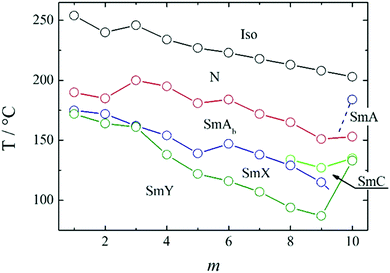 | ||
| Fig. 2 Phase diagram for the homologous series, CT6O.m. Melting points have been omitted for clarity. | ||
A twist-bend nematic phase is not observed on cooling the N phase for any length of alkyl terminal chain, m, but instead a sequence of up to four smectic phases is found. The smectic phases have been characterised using a combination of optical methods and X-ray diffraction.
The highest temperature smectic phase for homologues m = 1–9, has been assigned as an intercalated biaxial smectic A phase (SmAb). The SmAb phase is an orthogonal lamellar phase in which molecular rotation around the long axis is restricted. The restricted rotation results in different ‘in-plane’ polarizabilities, higher for the light polarized in the direction containing the dimer planes and lower perpendicular to this plane (Fig. S2, ESI†). The different polarizabilities translate to different in-layer refractive indices and therefore the SmAb phase exhibits optical biaxiality, which manifests as optical anisotropy when observed along the layer normal with POM. The schlieren texture (in cells with homeotropic anchoring, HT) contains predominantly two-brush point defects (Fig. 3). In HG cells, when viewed between crossed polarisers the light extinction directions are along the polariser and analyser, and the careful examination of the texture reveals regions of slightly different birefringence. The regions with lower birefringence dominate showing that most molecules are oriented with their dimer planes parallel the glass substrate. In wedge cells with HT anchoring, a characteristic texture was found, with stripes of different birefringence running across the schlieren pattern (Fig. S3, ESI†).26 For CT6O.m homologues with m = 1–9, the lowest angle signal in the X-ray diffraction pattern of the SmAb phase corresponds to ∼17–21 Å – approximately half the molecular length, l, indicating a locally intercalated structure (Fig. 4). The broad high-angle diffraction signal is indicative of liquid-like ordering within the layers.
The phase shown by homologues with m = 8 and 9 directly below the SmAb phase is a tilted smectic phase with a synclinic arrangement of the molecules in consecutive layers. The synclinically tilted structure is evidenced by the appearance of alternating domains across the focal conic optical texture with different extinction directions (Fig. 3); each domain can be brought into extinction condition upon rotation of the sample (Fig. S4, ESI†), allowing for the determination of the tilt angle, θ ∼ 5 deg.
The phase, when examined by dielectric spectroscopy appears to be non-polar (no dielectric relaxation mode was visible in the range up to MHz, Fig. S5, ESI†). However, on application of an electric field, a clear optical response has been observed, the tilted domains disappear and the extinction direction becomes along the layer normal (Fig. 5), while the birefringence increases (inset in Fig. 6). The switching is distinctly different than observed for bent-core mesogens in SmCP type phases; in the ferroelectric SmCSPF phase under an electric field, domains interchange the extinction directions without a change of birefringence, while in the antiferroelectric SmCsPA phase the synclinic domains disappear upon inducing an anticlinic ferro-structure but this is accompanied by a significant decrease of birefringence. The switching observed for the materials studied here may be explained in terms of a dielectrically induced rotation of the molecules on the tilt cone, as observed experimentally such rotation is not accompanied by repolarization current. Apparently at the transition from the SmAb to the SmC phase, molecules tilt with respect to the layer normal in such a way that their dimer planes are parallel to the tilt plane defined by director and layer normal (Fig. 5). On application of an electric field in HG cells the molecules rotate, keeping the orientation of their dimer planes unchanged with respect to the tilt plane (Fig. 5), and as a result the birefringence increases while the average projection of the long molecular axis on the cell substrate plane adopts the rubbing direction. The tilted domains of lower birefringence are restored when the electric field is removed. Apparently, this new type of switching is possible because of strong coupling between the tilt and orientation of the molecular plane, which prevents the rotation of molecules along their long axis without changing the tilt direction. In the XRD patterns of the SmC phase, the most intense small-angle signal corresponds to half the molecular length (Fig. 4), as in the SmAb phase, although a second, weak and slightly incommensurate signal is also present at a position corresponding to almost the full molecular length (∼40 Å). This implies frustration in the structure, with competition between intercalated and monolayer packing arrangements. As a result of the frustration the SmC phase has a modulated structure constructed from biaxial SmC layer fragments of length ∼250 Å.27 The broad wide-angle X-ray diffraction signal, only slightly narrower that in the preceding SmAb phase, indicates the lack of long range in-plane order (Fig. 4). Unfortunately, a sufficiently well-aligned sample could not be obtained in the modulated SmC phase to establish whether the plane of modulation is parallel or perpendicular to the tilt plane.
The additional smectic phases on the phase diagram (Fig. 2), denoted as SmX and SmY have more ordered structures as indicated by a narrowing of the high angle signals in their X-ray diffraction patterns (Fig. 4). In the SmX phase a single high angle signal is detected suggesting that the phase is a hexatic-type (possibly biaxial SmBhex phase), whereas in the SmY phase the signal splits into several, indicating long range positional ordering of the molecules inside the layer (a crystalline-type smectic phase, possibly SmE phase12). In both, SmX and SmY phases the most intense low angle diffraction signal also corresponds to half the molecular length, only a small increase in the layer spacing is seen at the SmAb–SmX or SmC–SmX phase transitions. In the SmY phase the layer spacing decreases and the presence of an additional signal at a lower diffraction angle suggests the phase has a modulated structure, with an additional in-plane density wave.28–30 Upon transition from the SmC phase to the SmX phase, the tilted domains disappear, and the phase returns to an optical texture with extinction directions along the polarizer and analyser with the optical birefringence nearly unchanged (Fig. 3). In cells with planar anchoring the SmY phase also exhibits a focal conic fan-like pattern, only differing from that seen for the SmAb and SmX phases by a small change in birefringence at the transition (Fig. 6). In cells with HT anchoring a plate-like mosaic texture is seen in the SmY phase (Fig. 3).
The longest homologue, the decyl-terminated CT6O.10, behaves quite differently. Specifically, it shows a sequence of four smectic phases below the nematic phase, and the highest temperature smectic phase appears at a considerably higher temperature than for the preceding homologue. Moreover, this phase gives a homeotropic texture in HT cells, indicative of a uniaxial smectic A phase. On cooling, the homeotropic texture is replaced by weakly birefringent schlieren, while in wedge cells stripe domains appear confirming formation of the SmAb phase. Interestingly, the X-ray diffraction experiments revealed that both the SmA and SmAb phases have a layer spacing of approximately 72 Å, corresponding to 1.7 times the molecular length of CT6O.10 (l ≈ 43 Å) (Fig. 4). This strongly suggests an interdigitated bilayer arrangement of the molecules in these lamellar phases, with segregation of the cyano groups at every second layer interface. The diffuse wide-angle diffraction signal indicates liquid-like ordering within the smectic layers. Although the layer spacing in the SmAb phase seen for CT6O.10 is dramatically different to that in the shorter homologues, the temperature of the phase appearance on cooling follows the general trend in the phase diagram (Fig. 2). Below the SmAb phase, a short range smectic C phase is observed, indicated by a fan texture with tilted domains in HG cells and a bright schlieren texture in HT cells. Surprisingly, the most intense low angle XRD signal in the SmC phase corresponds to half the molecular length (Fig. 4), suggesting that this phase has the intercalated structure, similar to that observed for the shorter homologues. The SmC phase retains the liquid-like in-plane ordering present in the higher temperature SmA and SmAb phases. The lowest temperature smectic phase exhibited by CT6O.10, the SmY phase, appears optically as a platelet- or mosaic-like texture, and has an X-ray diffraction pattern with the lowest angle signal located at approximately 1.5 times the molecular length l, indicating a shift back to an interdigitated molecular arrangement, similar to those seen for the SmA and SmAb phases. There are more than 10 harmonics related to the layer periodicity observed in the XRD pattern of the SmY phase, suggesting that this is a highly ordered lamellar phase, presumably a soft-crystal type lamellar phase. The signals in the wide angle region are considerably narrower than those seen in the preceding phases, and have a very similar pattern to those seen in the SmY phase of the shorter homologues.
The formation of intercalated smectic phases in cyanobiphenyl-based nonsymmetric dimers, and higher oligomers, is driven by a specific favourable interaction between the unlike mesogenic units.31–33 In the intercalated structure, the spacers and terminal chains are mixed. If the mesogenic units are approximately the same size, then, if the terminal chain length exceeds that of the spacer, the intercalated arrangement is destabilised, and smectic behaviour tends to be extinguished. On further increasing the terminal chain length, interdigitated smectic phases are observed stabilised by the interaction between the polar and polarisable cyanobiphenyl groups. In this arrangement the spacers and terminal form separation regions. In the CT6O.m series, however, the mismatch in the lengths of the mesogenic units allows for terminal chain lengths greater than the spacer length to be accommodated and an intercalated smectic A phase is observed for CT6O.9. To our knowledge CT6O.10 is the first example of a single compound in which a transition between intercalated and interdigitated phases is seen and the driving force for this remarkable behaviour is unclear.
Conclusions
In summary, we have synthesised a new series of odd-membered non-symmetric liquid crystalline dimers, the CT6O.m series, and characterised their phase behaviour using a combination of optical and X-ray diffraction techniques. Comparing the CT6O.m dimers to the previously reported CB6O.m dimers18 it is clear that replacing a biphenyl unit by a terphenyl one has a dramatic effect on the stability of liquid crystalline phases. In both series, the highest temperature phase is the conventional nematic phase, however the clearing temperatures, TNI, are by some 100 K higher for the terphenyl compounds (Fig. S1, ESI†). This is a result of the greater shape anisotropy of the mesogenic unit and significantly enhanced intermolecular interactions. Furthermore, a clear odd–even effect seen in TNI on varying m is evident in the CB6O.m series, whereas it quickly attenuates for the CT6O.m series. The absence of the odd–even effect in the terphenyl-based series may be attributed to the dominant effect of increasing terminal chain length being the dilution of the interactions between the larger mesogenic units on increasing the volume fraction of the alkyl chains. The twist-bend nematic phase observed for all the members of the CB6O.m series is not seen in their terphenyl analogues. Instead, a rich smectic polymorphism is observed, apparently the additional phenyl ring in one of the mesogenic cores stabilises smectic behaviour to such a large extent that it precludes the observation of the twist-bend nematic phase. For the CT6O.m homologues with m = 1–9, a series of up to four smectic phases is observed on cooling from the N phase, namely: an intercalated biaxial smectic Ab phase, a modulated phase made of tilted biaxial SmC layer fragments, a non-tilted biaxial hexatic-type phase termed the SmX phase, and a soft crystalline lamellar phase, SmY. The longest homologue, CT6O.10, exhibits a different sequence of smectic phases below the nematic phase: an uniaxial SmA phase, a biaxial SmAb phase, a tilted SmC phase, and the soft crystalline SmY phase. Interestingly, while in all smectic phases of homologues m = 1–9 the structure is intercalated, with smectic layer thickness d ∼ l/2, in homologue m = 10 only the SmC has an intercalated structure of molecules; all other smectic phases show interdigitated molecular packing arrangement, with periodicity d ∼ 2l. The change in structure of the phases between short and long homologues is induced by the competing tendencies toward intercalation, promoted by strong interaction between the mesogenic cores and leading to a structure with layers formed by half the molecule, and bilayer organization promoted by the self-segregation of cyano and alkyl terminal groups. In the case of homologues with m = 8 and m = 9, the frustration in molecular packing is relieved in the SmC phase by the formation of a 2D modulated structure. Interestingly, the strong biaxiality of the SmC phase results in an unusual switching mode detected under the application of an electric field, in which by coupling the dielectric anisotropy with the electric field, molecules in HG cells reorient to give an optical texture without tilt domains, and the switching is accompanied by a considerable increase in the measured birefringence.Conflicts of interest
There are no conflicts to declare.Acknowledgements
EG and DP acknowledge the support of the National Science Centre (Poland): (Grant Number 2016/22/A/ST5/00319). RW gratefully acknowledges The Carnegie Trust for the Universities of Scotland for funding the award of a PhD scholarship 2015–2018.References
-
R. B. Meyer, Les Houches Summer Sch. Theor. Physics, Mol. Fluids, Gordon And Breach, New York, 1976, pp. 316–320 Search PubMed
.
- I. Dozov, Europhys. Lett., 2001, 56, 247–253 CrossRef CAS
.
- M. Cestari, S. Diez-Berart, D. A. Dunmur, A. Ferrarini, M. R. De La Fuente, D. J. B. Jackson, D. O. Lopez, G. R. Luckhurst, M. A. Perez-Jubindo, R. M. Richardson, J. Salud, B. A. Timimi and H. Zimmermann, Phys. Rev. E: Stat., Nonlinear, Soft Matter Phys., 2011, 84, 031704 CrossRef CAS PubMed
.
- D. Chen, J. H. Porada, J. B. Hooper, A. Klittnick, Y. Shen, M. R. Tuchband, E. Korbloèa, D. Bedrov, D. M. Walba, M. A. Glaser, J. E. Maclennan and N. A. Clark, Proc. Natl. Acad. Sci. U. S. A., 2013, 110, 15931–15936 CrossRef CAS PubMed
.
- V. Borshch, Y. K. Kim, J. Xiang, M. Gao, A. Jákli, V. P. Panov, J. K. Vij, C. T. Imrie, M. G. Tamba, G. H. Mehl and O. D. Lavrentovich, Nat. Commun., 2013, 4, 2635 CrossRef CAS PubMed
.
- C. Zhu, M. R. Tuchband, A. Young, M. Shuai, A. Scarbrough, D. M. Walba, J. E. Maclennan, C. Wang, A. Hexemer and N. A. Clark, Phys. Rev. Lett., 2016, 116, DOI:10.1103/PhysRevLett.116.147803
.
- R. Walker, J. M. D. Storey, C. T. Imrie, D. Pociecha and E. Gorecka, Chem. – Eur. J., 2019, 25, 13329–13335 CrossRef CAS PubMed
.
- C. Greco, G. R. Luckhurst and A. Ferrarini, Phys. Chem. Chem. Phys., 2013, 15, 14961–14965 RSC
.
- A. A. Dawood, M. C. Grossel, G. R. Luckhurst, R. M. Richardson, B. A. Timimi, N. J. Wells and Y. Z. Yousif, Liq. Cryst., 2017, 44, 106–126 CAS
.
- R. J. Mandle, Soft Matter, 2016, 12, 7883–7901 RSC
.
- R. J. Mandle and J. W. Goodby, CrystEngComm, 2016, 18, 8794–8802 RSC
.
- E. E. Pocock, R. J. Mandle and J. W. Goodby, Molecules, 2021, 26, 532 CrossRef CAS PubMed
.
- M. Šepelj, A. Lesac, U. Baumeister, S. Diele, H. L. Nguyen and D. W. Bruce, J. Mater. Chem., 2007, 17, 1154–1165 RSC
.
- D. A. Paterson, C. A. Crawford, D. Pociecha, R. Walker, J. M. D. Storey, E. Gorecka and C. T. Imrie, Liq. Cryst., 2018, 45, 2341–2351 CrossRef CAS
.
- R. Walker, D. Pociecha, A. Martinez-felipe, J. Storey, E. Gorecka and C. T. Imrie, Crystals, 2020, 10, 175 CrossRef CAS
.
- J. P. Abberley, R. Killah, R. Walker, J. M. D. Storey, C. T. Imrie, M. Salamończyk, C. Zhu, E. Gorecka and D. Pociecha, Nat. Commun., 2018, 9, 228 CrossRef PubMed
.
- M. Salamończyk, N. Vaupotič, D. Pociecha, R. Walker, J. M. D. Storey, C. T. Imrie, C. Wang, C. Zhu and E. Gorecka, Nat. Commun., 2019, 10, 1922 CrossRef PubMed
.
- R. Walker, D. Pociecha, G. J. Strachan, J. M. D. Storey, E. Gorecka and C. T. Imrie, Soft Matter, 2019, 15, 3188–3197 RSC
.
- S. P. Sreenilayam, Y. P. Panarin, J. K. Vij, V. P. Panov, A. Lehmann, M. Poppe, M. Prehm and C. Tschierske, Nat. Commun., 2016, 7, 11369 CrossRef CAS PubMed
.
- H. Takezoe, E. Gorecka and M. Čepič, Rev. Mod. Phys., 2010, 82, 897–937 CrossRef CAS
.
- D. A. Paterson, M. Gao, Y. K. Kim, A. Jamali, K. L. Finley, B. Robles-Hernández, S. Diez-Berart, J. Salud, M. R. De La Fuente, B. A. Timimi, H. Zimmermann, C. Greco, A. Ferrarini, J. M. D. Storey, D. O. López, O. D. Lavrentovich, G. R. Luckhurst and C. T. Imrie, Soft Matter, 2016, 12, 6827–6840 RSC
.
- D. A. Paterson, J. P. Abberley, W. T. A. Harrison, J. Storey and C. T. Imrie, Liq. Cryst., 2017, 44, 127–146 CAS
.
- E. E. Pocock, R. J. Mandle and J. W. Goodby, Soft Matter, 2018, 14, 2508–2514 RSC
.
- R. J. Mandle, M. P. Stevens and J. W. Goodby, Liq. Cryst., 2017, 44, 2046–2059 CrossRef CAS
.
- R. Walker, M. Majewska, D. Pociecha, A. Makal, J. M. D. Storey, E. Gorecka and C. T. Imrie, ChemPhysChem, 2021, 22, 461–470 CrossRef CAS PubMed
.
- R. Pratibha, N. V. Madhusudana and B. K. Sadashiva, Europhys. Lett., 2007, 80, 46001 CrossRef
.
- Y. Kimoto, A. Nishizawa, Y. Takanishi, A. Yoshizawa and J. Yamamoto, Phys. Rev. E: Stat., Nonlinear, Soft Matter Phys., 2014, 89, 42503 CrossRef PubMed
.
- J. Prost and P. Barois, J. Chem. Phys., 1983, 80, 65 CAS
.
- Y. Shi, G. Nounesis and S. Kumar, Phys. Rev. E: Stat., Nonlinear, Soft Matter Phys., 1996, 54, 1570–1573 CrossRef CAS PubMed
.
- D. Pociecha, N. Vaupotič, E. Gorecka, J. Mieczkowski and K. Gomola, J. Mater. Chem., 2008, 18, 881–885 RSC
.
- G. S. Attard, R. W. Date, C. T. Imrie, G. R. Luckhurst, S. J. Roskilly, J. M. Seddon and L. Taylor, Liq. Cryst., 1994, 16, 529–581 CrossRef CAS
.
- C. T. Imrie, P. A. Henderson and J. M. Seddon, J. Mater. Chem., 2004, 14, 2486–2488 RSC
.
- C. T. Imrie, Liq. Cryst., 2006, 33, 1449–1485 CrossRef CAS
.
Footnote |
| † Electronic supplementary information (ESI) available: Synthetic procedures and analytical data; supporting figures. See DOI: 10.1039/d1tc00904d |
| This journal is © The Royal Society of Chemistry 2021 |

